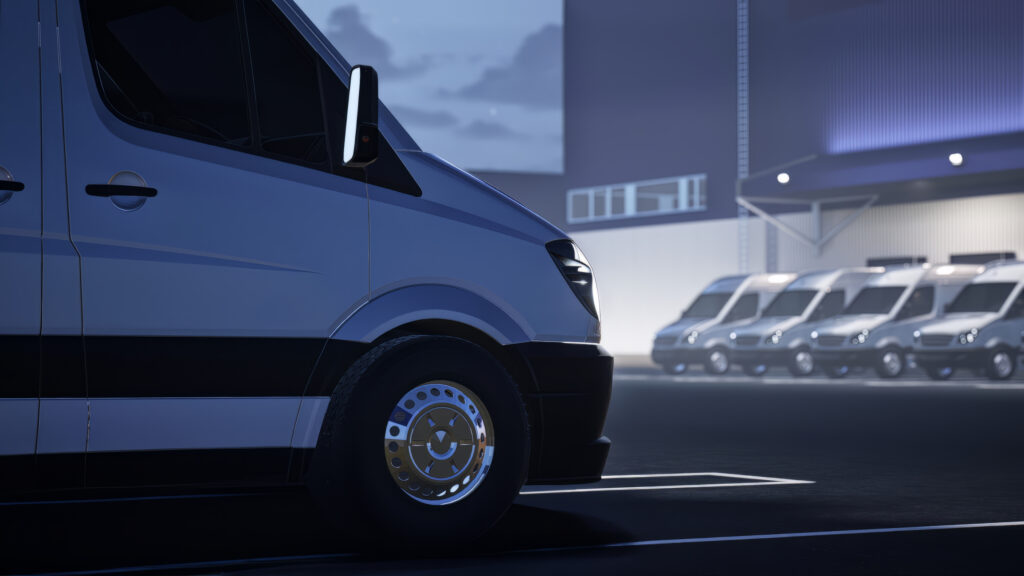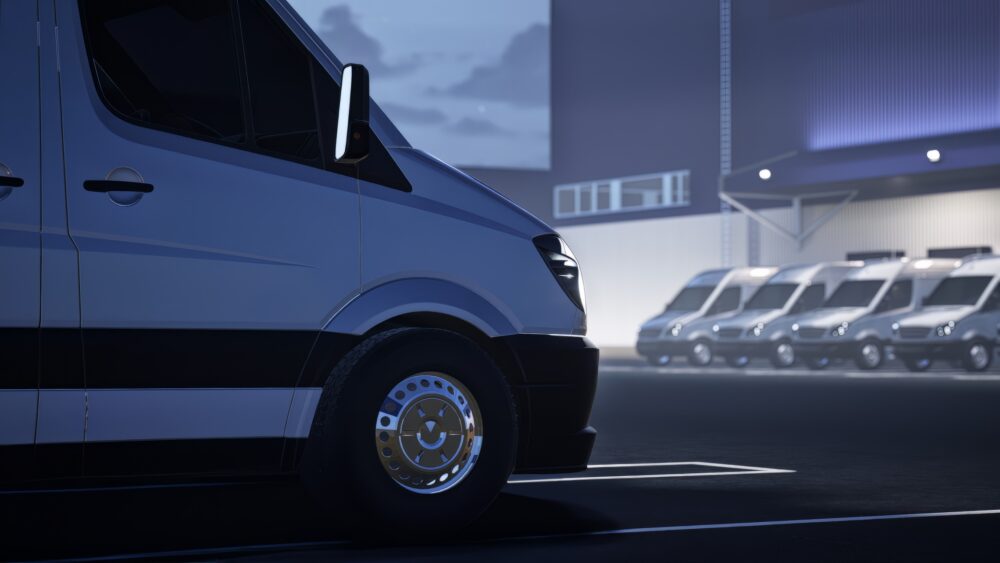14 April 2025

Light-commercial vehicle (LCV) registrations in the UK continued to struggle in March. Meanwhile, the used-van market improved. Andy Picton, specialist residual value analyst at Glass’s, analyses the market with Autovista24 special content editor, Phil Curry.
The UK’s new LCV market dropped for the fourth-consecutive month. A total of 51,221 new vans, pickups and chassis variants took to the country’s roads, down 3.2% year on year.
The new plate month of March saw demand fall across many sectors. The biggest drop occurred in the market for vans between 2.5 and 3.5 tonnes gross vehicle weight (GVW), which fell 10%.
This sector registered 32,025 new units, which was 3,567 fewer deliveries than in March 2024. However, it continues to be the most popular option, representing over 62.5% of all units registered.
Vans weighing between 2 and 2.5 tonnes GVW recorded an 8.5% drop last month, equating to 759 fewer units.
Demand for vans under than 2 tonnes GVW saw registrations increase for the 13th successive month, up 60.8% to 1,585 units.
The pickup sector recorded a 40.6% rise in registrations as operators pushed to get their new double-cab pickups on the road. This is due to changes to Benefit in Kind (BIK) and capital allowances, which came into effect from 1 April.
A total of 8,107 new pickups hit the road in March, compared to 5,767 units in the 12 months prior. The sector made up 15.8% of all registrations.
Without this large rise in pickup registrations, March’s totals would have been much lower. This indicates that many businesses are currently holding off from investing in what is a highly challenging economic environment.
Ford dominates the market
Ford’s dominance in the LCV market saw the marque take the top three spots on the best-seller table last month.
The Ford Transit Custom registered more than twice as many models as the second-placed Ranger pickup. The model outsold its sibling, the Transit, as businesses raced to beat the BIK rule changes. At the end of the third quarter, sales of these three models equated to over a third of all LCV registrations in the UK.
Stellantis Pro One saw the Vauxhall Vivaro place fourth with 2,028 units and the Citroen Berlingo sixth with 1,671 units. In addition, the brand secured eighth with the Peugeot Partner (1,617 units) and the Peugeot Expert ended the month in ninth (1,523 units).
The Renault Trafic took fifth with 2,013 registrations, whilst the Volkswagen Crafter finished seventh and the Toyota Hilux 10th, registering 1,649 units and 1,385 units respectively.
ZEV mandate changes
This market share is well below the 16% target that van manufacturers need to meet this year as part of the zero-emission vehicle (ZEV) mandate. However, the UK government has made several revisions to make avoiding financial penalties easier.
Van makers can balance the annual targets against each other and avoid fines by selling more battery-electric vehicles (BEVs) in the later years of the mandate. The transfer of non-ZEVs to ZEVs was originally in place from 2024 to 2026, but has now been extended to 2029.
This gives additional flexibility to reward CO2 savings from hybrids. Existing CO2 test values for plug-in hybrids (PHEVs) will continue to be used instead of revised higher results from the Euro 6e-bis test being used in the EU.
In addition, there is now flexibility for vehicle transfers should a manufacturer overachieve on targets. Should a vanmaker overachieve against the LCV targets but under-deliver with cars, it can transfer those excess credits to its car sales. One LCV credit can be exchanged for two car credits, and one car credit can be exchanged for 0.4 LCV credits.
Fines for those manufacturers not able to meet ZEV mandate targets will also be reduced by 18%, from £18,000 (€20,901) to £15,000 for every LCV.
Petrol and diesel LCVs can now be sold alongside full hybrid models and PHEVs until 2035. Meanwhile, small and micro-volume manufacturers will be exempt from ZEV mandate targets.
However, while these amendments will help the market, the UK government can help increase electric-van uptake by authorising a van-specific charging infrastructure alongside effective regulation to support market growth.
Electric boost
Battery-electric vans up to 4.25 tonnes GVW grew their registrations for the sixth month in a row. A 40.3% rise saw registrations hit 4,215 units in March, compared to 3,044 units from 12 months prior. This represented a monthly market share of 8.2%, up 2.5 percentage points (pp) from the same period last year. BEVs captured 8.3% of overall LCV deliveries in the first quarter, up 2.8pp.
Vauxhall accounted for 23.1% of all new BEVs registered in March. Ford took second with 22.7%, and Volkswagen claimed third with 15%. Nissan was fourth with 7.4%, and Toyota finished fifth with 7.1%.
Sixth was held by Renault with 94 units (2.2%), while Mercedes-Benz took seventh with 222 units (5.3%). Peugeot ended the month in eighth with 209 units (4.9%), Maxus in ninth with 183 units (4.3%) and Citroen was 10th with 86 units (2%).
By range, the Ford E-Transit Custom accounted for 18.7% of all new electric vans registered in the month, with 790 units. The VW ID. Buzz Cargo was second with 634 units delivered, followed by the Vauxhall Vivaro Electric with 602 units. Fourth went to the Vauxhall Combo Electric with 374 units, while the Nissan Townstar EV rounded out the top five with 312 units.
The PHEV van market saw Ford, Toyota, Volkswagen and LEVC register 1,635 units between them during March. Ford registered 817 Transit Custom PHEVs and 385 Transit Connect PHEVs.
Toyota registered 419 Corolla Commercials, while VW saw 13 Caddy PHEVs delivered, and LEVC registered one VN5 van. In the year to date, 2,905 hybrid LCVs have been registered, with Ford accounting for 65.5% of the market.
Better news for used-van market
A good balance of stock and positive buyer activity has increased sales during March. Clean, low-mileage stock continues to attract the fiercest competition and strongest prices. As a result, average sales prices have increased over the month. Stock with higher miles and exhibiting more damage struggle in comparison, selling for below expected levels.
The supply and demand of stock to the used market was well-balanced during the first quarter, with the second quarter set to see some seasonality. Overall, these stable market conditions are expected to remain in place throughout the first half of the year.
It is only later, in 2025 and into 2026, that values may come under pressure. This would be due to the reduction in new LCV registrations during 2022, impacting volumes of three-year-old stock available in the used market.
Further increase at auction
Sales of vehicles at auction increased for the fourth successive month, rising over 2% compared to February. The average age of stock over this period decreased from 79.1 months to 74.8 months and was 4.1 months younger than 12 months prior.
Average mileage fell 0.1% to 78,730 miles during the month and 2.9% over the year. These factors helped to boost average sales prices by over 7.3%.
Of the vehicles sold at auction in March, 76% were Euro 6, a 0.7% increase compared to February. The average age was 55.3 months with an average mileage of 72,515 miles, compared to 70,698 miles in February. Euro 5 stock accounted for 22.3% of sales, down 0.6% on February.
Medium sized vans continue to be the most desirable in the used market, with sales accounting for 40.1% of the overall total. Small vans followed some way behind with 25.8%, then large vans with 22.8%.
Volumes of 4×4 Pickup sales accounted for 11.3% of the total sales, up from 8.6% in February. This sector recorded the highest average sale price at £13,434, up 1.8% on the previous month. Large vans covered more distance than any other vehicle type at an average of 87,392 miles, up over 6,500 miles compared to February.
Overall first-time conversion rates increased from 73.7% to 76.9% in March. This was 0.5% higher than the same point in 2024.
Broken down, the best conversion rate was achieved in the small van sector at 82.1% (up 4% on February), followed by the medium van sector at 77.9% (up 4%) and the Large Van sector at 73.2% (up 2.4%). A conversion rate of 68.8% (down 5%) in the 4×4 pickup sector returned the lowest.
Positivity for used market
Used vehicles observed for sale in the retail market last month increased by over 5.5% to 48,000 units. Of these, 92.7% were diesel models, 4.4% were BEVs, 2% were petrol, and 0.6% were PHEVs. A total of 36.6% of all vehicles on sale were valued at £20,000 or more, while 36.4% were on sale for between £20,000 and £10,000.
Vehicles on sale between £10,000 and £5,000 made up 21.3% of the overall market, while 5.7% were on sale for less than £5,000.
White vehicles make up just over half of all vans on sale at 50.8%, followed by grey at 15.6%, silver at 10.2%, black at 9.9% and blue at 6.5%. Average age fell by one month to 58 months, while average mileage increased by 0.1% to remain at just under 57,000 miles.
March saw more electric vans enter the used market. However, sales of stock remained static at 1.68%. The average age of all BEVs sold fell from 46.3 months to 41.6 months, down from 50.4 months 12 months previously.
Average mileage increased from 33,932 miles to 34,449 miles over the month, with this figure over 4,800 miles higher than March 2024. The average first-time conversion rates improved by 3.5% to 50.9% in March. Yet, in contrast to internal-combustion engine (ICE) vehicle conversions, this figure remains 25% lower. Average sale prices increased 4.3% to just under £8,150.
Broken down, small electric vans were the most popular. The segment accounted for 67.3% of all sales and travelled the most miles at 43,220. Furthermore, it achieved the best conversion rate at 62.2%.





